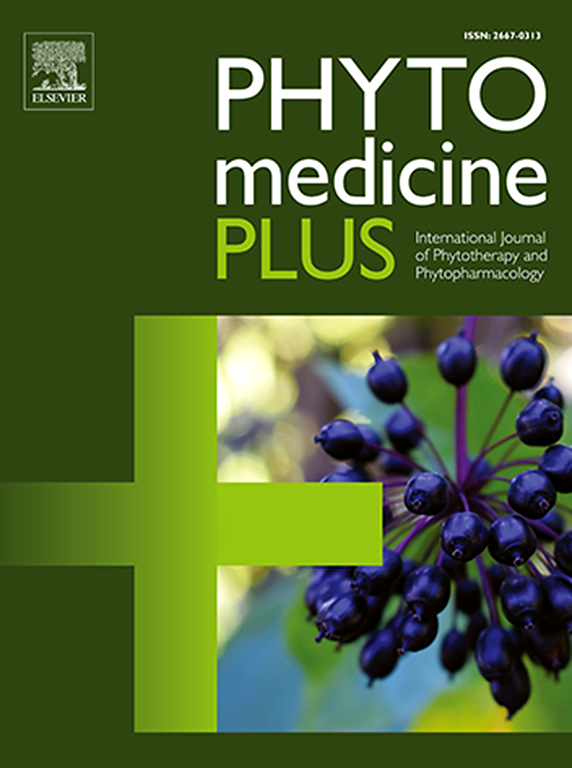Herbal tea prepared in-house shows potential immunomodulatory activity in cyclophosphamide-induced myelosuppression in rats
Q3 Pharmacology, Toxicology and Pharmaceutics
引用次数: 0
Abstract
Background
Withania somnifera, Tinospora cordifolia and Glycyrrhiza glabra, popular herbs in Ayurveda, have been reported to modulate and enhance immune functions. Similarly, Ocimum sanctum, Ocimum gratissimum and Camelia sinensis have also been used as immunomodulatory agents in Ayurvedic system of medicine. Considering the individual pharmacological properties of these six above-mentioned plants, we prepared herbal tea (HT) and evaluated its immunomodulatory effects.
Objective
This study aimed at establishing the immunomodulatory potential of in-house herbal tea, both in vitro and in vivo.
Material and methods
Aqueous infusion of HT was prepared and its total phenolic and total flavonoid content was determined. Phytochemical analysis was performed using UPLC![]() HRMS. The aqueous extract was then evaluated for in vitro cytotoxicity and Nitric oxide release in RAW 264.7 cells. The immunomodulation potential of HT in vivo was studied in male/female SD rats and the model was developed by using cyclophosphamide (CTX).
HRMS. The aqueous extract was then evaluated for in vitro cytotoxicity and Nitric oxide release in RAW 264.7 cells. The immunomodulation potential of HT in vivo was studied in male/female SD rats and the model was developed by using cyclophosphamide (CTX).
Results
Phytochemical analysis of HT showed the presence of gallic acid, glycyrrhizin, catechin, epigallocatechin gallate, vicenin and chlorogenic acid. HT1 (100 mg/kg) could significantly inhibit reduction in body weight and weight of thymus and spleen. Also, it improved the leucocyte count, both total and differential, phagocytic index, neutrophil adhesion and level of IL-1β (47.12 %) and IL-6 (44.77 %). Further, the HT prevented destruction of normal vascular organization and cellular composition of spleen and thymus tissues.
Conclusion
The findings of the study suggest that the immune booster herbal tea at the dose 100 mg/kg, ameliorates CTX-induced myelosuppression and immunosuppression in rats and possesses potent immunomodulatory activity.

室内制备的凉茶显示了对环磷酰胺诱导的大鼠骨髓抑制的潜在免疫调节活性
据报道,印度草药中常用的一些草药,如苦荬菜、堇青花和甘草具有调节和增强免疫功能的作用。同样,在阿育吠陀医学体系中,茴香、茴香和山茶也被用作免疫调节剂。考虑到上述6种植物的个体药理特性,我们制备了凉茶,并评价了其免疫调节作用。目的研究国产凉茶在体外和体内的免疫调节作用。材料和方法制备HT水浸液,测定其总酚和总黄酮含量。采用UPLCHRMS进行植物化学分析。然后评估水提物在RAW 264.7细胞中的体外细胞毒性和一氧化氮释放。研究HT在雄性/雌性SD大鼠体内的免疫调节潜能,并用环磷酰胺(cyclophosphamide, CTX)建立模型。结果植物化学分析结果显示未食子酸、甘草酸、儿茶素、表没食子儿茶素没食子酸酯、维森菌素和绿原酸。HT1 (100 mg/kg)能显著抑制大鼠体重和胸腺、脾脏重量的下降。白细胞总数、白细胞分化数、吞噬指数、中性粒细胞粘附、白细胞介素-1β(47.12%)和白细胞介素-6(44.77%)水平均有显著提高。此外,HT还能防止脾脏和胸腺组织正常血管组织和细胞组成的破坏。结论100 mg/kg剂量的免疫增强凉茶可改善ctx诱导的大鼠骨髓抑制和免疫抑制,具有较强的免疫调节作用。
本文章由计算机程序翻译,如有差异,请以英文原文为准。
求助全文
约1分钟内获得全文
求助全文
来源期刊

Phytomedicine Plus
Medicine-Complementary and Alternative Medicine
CiteScore
3.70
自引率
0.00%
发文量
178
审稿时长
81 days
期刊介绍:
 求助内容:
求助内容: 应助结果提醒方式:
应助结果提醒方式:


